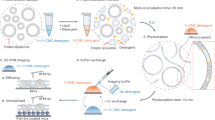Abstract
CELL stimulation causes diacylglycerol kinase (DGK) to convert the second messenger diacylglycerol into phosphatidate, thus initiating the resynthesis of phosphatidylinositols and attenuating protein kinase C activity1. Of the DGK isoforms so far reported2–4, only porcine DGK from lymphocytes5 has been characterized in detail3,5–7. Here we report the isolation and sequencing of complementary DNA clones that together cover the entire region encoding porcine DGK (relative molecular mass 80,000 (80K)). The deduced primary structure of this DGK contains the putative ATP-binding sites, two cysteine-rich zinc finger-like sequences similar to those found in protein kinase C8, and two E–F hand motifs, typical of Ca2+-binding proteins like calmodulin9. Indeed, we find that the activity of this DGK isoform is enhanced by micromolar concentrations of Ca2+ in the presence of deoxycholate or sphingosine. These properties of 80K DGK indicate that its action is probably linked with both of the second messengers diacylglycerol10 and inositol 1,4,5-trisphosphate11.
This is a preview of subscription content, access via your institution
Access options
Subscribe to this journal
Receive 51 print issues and online access
$199.00 per year
only $3.90 per issue
Buy this article
- Purchase on Springer Link
- Instant access to full article PDF
Prices may be subject to local taxes which are calculated during checkout
Similar content being viewed by others
References
Kanoh, H., Yamada, K. & Sakane, F. Trends Biochem. Sci. 15, 47–50 (1990).
Yamada, K. & Kanoh, H. Biochem. J. 255, 601–608 (1988).
Sakane, F., Yamada, K. & Kanoh, H. FEBS Lett. 255, 409–413 (1989).
MacDonald, M. L., Mack, K. F., Williams, B. W., King, W. C. & Glomset, J. A. J. biol. Chem. 263, 1584–1592 (1988).
Yamada, K., Sakane, F. & Kanoh, H. FEBS Lett. 244, 402–406 (1989).
Kanoh, H., Kondoh, H. & Ono, T. J. biol. Chem. 258, 1767–1774 (1983).
Kanoh, H., Iwata, T., Ono, T. & Suzuki, T. J. biol. Chem. 261, 5597–5602 (1986).
Nishizuka, Y. Nature 334, 661–665 (1988).
Kretsinger, R. H. Adv. Cyclic Nucleotide Res. 11, 1–26 (1979).
Nishizuka, Y. Nature 308, 693–697 (1984).
Berridge, M. J. & Irvine, R. F. Nature 341, 197–205 (1989).
Kozak, M. Cell 44, 283–292 (1986).
Berg, J. Science 232, 485–487 (1986).
Ono, Y. et al. Proc. natn. Acad. Sci. U.S.A. 86, 4868–4871 (1989).
Csermely, P., Szamel, M., Resch, K. & Somogyi, J. J. biol. Chem. 263, 6487–6490 (1988).
Emori, Y. et al. J. biol. Chem. 261, 9465–9471 (1986).
Tufty, R. H. & Kretsinger, R. H. Science 187, 167–169 (1975).
Chou, P. Y. & Fasman, G. D. A. Rev. Biochem. 47, 251–276 (1978).
Hunter, T. Cell 50, 823–829 (1987).
Loomis, C. R., Walsh, J. P. & Bell, R. M. J. biol. Chem. 260, 4091–4097 (1985).
Kanoh, H., Yamada, K., Sakane, F. & Imaizumi, T. Biochem. J. 258, 455–462 (1989).
Kishimoto, A. et al. J. biol. Chem. 260, 12492–12499 (1985).
Ohno, S. et al. Nature 325, 161–166 (1987).
Takai, T., Yokoyama, C., Wada, K. & Tanabe, T. J. biol. Chem. 263, 2651–2657 (1988).
Gubler, U. & Hoffman, B. J. Gene 25, 263–269 (1983).
Yanisch-Perron, C., Vieira, J. & Messing, J. Gene 33, 103–119 (1985).
Sanger, F., Nicklen, S. & Coulson, A. R. Proc. natn. Acad. Sci. U.S.A. 74, 5463–5467 (1977).
Maniatis, T., Fritsch, E. F. & Sambrook, J. Molecular Cloning: A Laboratory Manual (Cold Spring Harbor Laboratory, New York, 1982).
Feinberg, A. P. & Vogelstein, B. Analyt. Biochem. 132, 6–13 (1983).
Laemmli, U.K. Nature 227, 680–685 (1970).
Putkey, J. A. et al. J. biol. Chem. 258, 11864–11870 (1983).
Wilkinson, J. M. Eur. J. Biochem. 103, 179–188 (1980).
Kuwano, R. et al. FEBS Lett. 202, 97–101 (1986).
Burgess, G. M., Mckinney, J. S., Fabiato, A., Leslie, B. A. & Putney J. W. Jr J. biol. Chem. 258, 15336–15345 (1983).
Author information
Authors and Affiliations
Rights and permissions
About this article
Cite this article
Sakane, F., Yamada, K., Kanoh, H. et al. Porcine diacylglycerol kinase sequence has zinc finger and E–F hand motifs. Nature 344, 345–348 (1990). https://doi.org/10.1038/344345a0
Received:
Accepted:
Issue Date:
DOI: https://doi.org/10.1038/344345a0
This article is cited by
-
Combination therapy for hepatocellular carcinoma with diacylglycerol kinase alpha inhibition and anti-programmed cell death-1 ligand blockade
Cancer Immunology, Immunotherapy (2022)
-
Expression and localization of diacylglycerol kinase ζ in guinea pig cochlea and its functional implication under noise-exposure stress conditions
Histochemistry and Cell Biology (2019)
-
Bacterial expression strategies for several Sus scrofa diacylglycerol kinase alpha constructs: solubility challenges
Scientific Reports (2013)
-
Protein kinase C regulates the nuclear localization of diacylglycerol kinase-ζ
Nature (1998)
-
Molecular cloning of a cDNA encoding diacylglycerol kinase (DGK) in Arabidopsis thaliana
Plant Molecular Biology (1996)
Comments
By submitting a comment you agree to abide by our Terms and Community Guidelines. If you find something abusive or that does not comply with our terms or guidelines please flag it as inappropriate.



